Mind Streaming
John Coxon's Online Journal|
Archive Search |
| Links |
|
and s-integrator |
Saturday, May 24, 2003
SWINTON HISTORY
Friday, May 23, 2003
Can you guess what this small but sturdy stoneware ceramic item, I now use for plants, was originally used for and why it is of significant in terms of where I live? Click on the image for the answer.
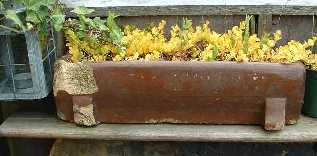
johncoxon 10:38 PM - [Link] - Comments ()
...
Thursday, May 22, 2003

"In for a penny; in for a pound", an old English saying goes, or "in for a dime, in for a dollar ", an old American saying goes. Once involved, you mustn't stop at half-measures, I think it means. So you have to ask, why we are members of the European Union, but he current governement continues to wring its hands about abandoning the tradtional Pound Sterling and adopting the Euro? You'd think their would be obvious trade benifits in sharing the same currency with our nearest neighbours, and certainly many travellers would welcome not having the hassle of needing to physically and mentally convert currency or paying annoying commision charges to money changers.
Some resistance to change is based on simple conservatism ; a morbid fear of belonging to a modern confederate European state, amd where embracing the new coinage at the 'expense' of our own, would symbolically , to some die-hards, herald a loss of national sovereignty and identity. Were common sense to prevail, we'd adopt the Euro, and, like all other member nation states, would retain the right to design our own 'head'. We'd very probably continue to opt for the old favourite, " monarch with the re-assuring side-ways glance " motif with an image of the Queen on the obverse of the new coin.
.The loss of the word Pound would be no big deal ; we have lost other coin words, for ever, in the near and distant past. The guinea, sovereign, shilling, crown, half-crown, sixpence, halfpenny, the florin, farthing and the groat amongst others have disappeared from our language, in my time, without too many tears, although, writing down those names now makes me a little sentimental and nostalgic.(The gold sovereign , though not 'legal tender', is still minted to enable people to either hoard solid gold, or more often display it on rather tastleless jewelry to give the illusion of wealth)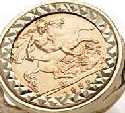
The same small change misguided controversy, it seems to me, surrounded events of February 15th, 1971, a date which I have personal reason to celebrate so warmly as the day my money problems ended. On that glorious day, the ridiculous mathematics of a currency based on multiples of twelve were abandoned for ever. We finally caught up with the more sensible rest of the word and adopted decimal currency.
As a young child, barely seven, in Primary School, three mathematical signs could bring tears of frustration to my eyes. They were £ : s : d. (Pounds, shillings and pence.) Those were the days when there were 240 pennies to the old pound and those pages of adding or subtracting amounts of money under three columns, we had to do, (when I was the reluctant slave of the Imperial System so to speak,) were, for me, a complete nightmare. I am beginning to sweat as I write about it now. It was so humiliating.
Whilst I hated the enforced classroom mathematics of pre-decimal coinage, I loved the look and feel of the old small change ( and in those days, when you could fill the petrol tank for ten shillings, my pocket rarely held a bank note.) Most small change then , as they no longer do, bore the head, facing this way or that, of a number of recent monarchs ; along with Elizabeth, on our small change, we had pictures of Kings George and Edward, and even, occasionally, on those big copper pennies we had , (with that steadfast symbol of Britishness, Britannia, on the reverse,)
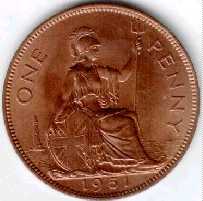
you'd occasionally find the age-blackened image of Queen Victoria, either the "We are not amused", older image, or the 'Bun Penny', from happier days in her reign when her hair tresses wer tied elegantly back in a 'bun'.
Coins, the further back you went, seemed to be made of softer metals and alloys.('Milling' was invented to stop the common , anciient practice of cropping gold and silver from the edges of coins made from the noble metals. )
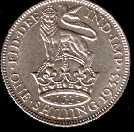
I remember, in my late teens, making silver rings from old shillings which still had a high silver content. By striking the milled edges, held between my fingers , with a steel table spoon, tiny facets would form and , in time, constantly turning the coin in my fingers, the edges would spread out to make an even-width rim. Then I'd drill out the centre and use a 'rat-tail' metal file to clear the remaining metal waste to leave a perfect ring.

By the late fifties, two coins had become a bit of a nuisance because they were worth so little ;the farthing, which had a beautiful image of one of our smallest native hedgerow birds, the wren; the halfpenny (pronounced
"ha'pny") bore a portrait of, I think, Sir Francis Drake's sailing ship, the 'Golden Hind.'
Angela tells me that the word 'ha'ppeny' also had a special northern meaning for the mill girls of Lancashire in former times when the halfpenny still had some real value. On their annual mill 'picnic' holiday trips to the seaside nothern towns of Blackpool or Morecambe, their mother's might warn them (as did a ribald old music hall song) of predatory males and counselled them to "Keep yer 'and on your ha'penny", (i.e. guard that which was precious then, for an unamarried girl, and which could not be restored, once 'taken'.
There were still, way back then , things bought and sold for guineas, ( One pound and a shilling) like paintings and race horses ; in former times professionals charged fees in the more elegant sounding 'guineas', kept, we hear the pound, and used the shilling to pay their clerks !
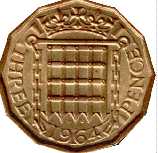
Next up, the quaint, oddly geometrically shaped , twelve-sided brass 'three penny' piece ( then pronounced 'thrupence' or 'thrupenny' bit ,) which had on the reverse the image of a portcullis, (the iron grided, rise-and-fall gates that traditionally protected the entrance to ancient fortifications in the days when the castle moat could only be crossed when the drawbridge was lowered.) I don't remember coins called 'crowns' were current in my young days, although the half-a-crown ( 2s:6d / two shillings and sixpence ) was, I have to say, my weekly pocket money into the mid-sixties for me, alas, and that severely curtailed many activities and required me to do a large number of jobs for my parents to make any more, like going to the beach and bringing back drift wood, on my home made, pram-wheeled, 'trolley; for them to burn on the family fire.
,br> The 'florin' was around, but better known, in my childhood,as a two shilling piece, and then the shilling, always known as a'Bob.' ( I can't ,for the life of me, explain the origin of the word, Bob, although it might be related to Robert Peel, Bob as in 'bobbies'( English policeman that he invented)
br>The 'bob' ( shilling) was the amount offered for volunteer soldiers, incidentally, in the First World War, to young men who signed up to go to war, and were bribed by the offer of the 'king's shilling.The 'bob' was immortalised , too, in the annual boy scout national fund raiser back then. Kids in Cub and Scout uniforms went from door-to-door, offering to run errands, clean windows and cars, for example, during 'Bob A Job Week.' The household's that employed these kids ( or often, as I remember , gave them a 'bob' just to make the go away !) with a simple chore, were awarded a self adhesive yellow sticker which had a large red tick on it, and this they stuck the 'receipt'on a prominent street-facing window. This had the dual function of discouraging further intrusion from the "Baden Powell pester army", and informed the neighbours that the residents of your house were kind and giving.
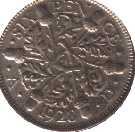
Another favourite coin was the tiny silver and nickel sixpence, known affectionately, nationally, as a 'tanner'. Around the age of ten years, I used to go, regularly to the 'Gaumont' or, more often, Odeon cinema in Weymouth to watch mostly American cowboy pictures , in the days when the 'Baddies'wore black hats and the 'Goodies'had the white hats and Indians didn't wear hats. whilst cowboys were, i observed totally immune to bullets and arrows, the injuns, following the crack of various Winchester Repeater rifles, fell like skittles, (skilfully, it turns out, from their saddle-less ponies onto what I now realise was Hollywood soft sand)
These were the days of velvet curtained innocence and safety curtain fire drills;the" Saturday Club" cinema - going kids, paid their 'tanner' entrance money and proceedings started with singing, in raucous unison, "We come along, on Saturday morning, greeting everybody with a smile. We come along on Saturday morning, knowing that its so worthwhile." The 'tanner'days were those when the majority rose and still stood at the end of cinema performances for the national anthem which was always played.
To the best of my knowledge, the old 'tanner'or sixpence, remains in daily use in only one location ; not in some backwater of the Empire, but in the hands of someone with royal connections, though not related to our gracious queen, although he has entertained on the roof of one of her palaces ( I am not convinced he entertained her exactly) Brian May, lead guitarist of legendary rock band "Queen" maintains a unique sound from his electric guitar by using a silver sixpence as a plectrum to this day.
Finally, there was also a much loved brownish-coloured banknote, featuring Elizabeth Regina looking so much younger then , than now. this was the 'ten bob note', a banknote for ten shillings, and origin of the phrase, "as queer as a nine bob note", which was once a way of describing gay men , or something that veered from the norm.
In my childhood those small coins that have now gone, had value and you could save until you could exchange them for the cherished 'ten bob' note , which today, we'd call 50 pence or half of the modern pound sterling. When I was reminiscing with Angela about old coins and the value of old money , she announced that she still had a 'ten bob' note. Apparently, her late father had left one in his insurance book, in the days when insurance men from the 'Prudential' and Co-op insurance company called, door-to door, weekly, at many northern homes. Clearly her dad had slotted the note in the book to make a payment but ceased to be before he could do that. Here it is, both sides , in all its glory. a British banknote, from earlier days, sadly missed, but here, still with us.
Click on the words tenbob
to view.
johncoxon 2:40 AM - [Link] - Comments ()
...
A PAST ROYAL WARRANT HOLDER
Wednesday, May 21, 2003
Any idea of the identity of this character ?
He was a British inventor, opportunist and astute business person and, moreover, indeed , supplier of special thrones to royalty.
Click on his image to find out who this illustrious, amiable looking person was.
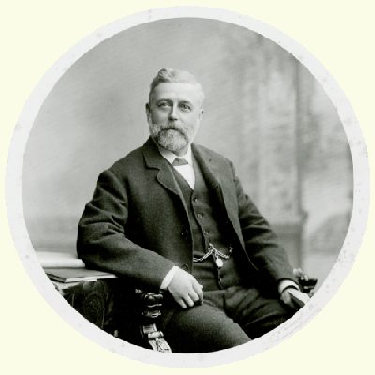
johncoxon 12:16 AM - [Link] - Comments ()
...
A QUAINT BRITISH PRACTICE
Tuesday, May 20, 2003
What do a bottle of HP (Houses of Paliament ) brown sauce, a canister of table salt, a bag of sugar, a bottle of Worcester sauce and a jar of Sharwood's mango chutney all have in common? What do they share in common with Steinway pianos, IBM computers, William Caxton and Thomas Crapper? The answer is that they are all the producers/ suppliers of goods or manufactured items, which have 'Royal Warrants.'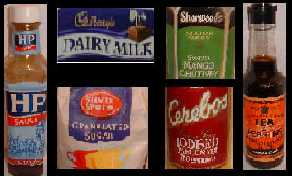
The quaint practice of 'Royal Warrants' has its beginnings in the 15th century when royal tradesmen, who supplied the sovereign with goods and or services, were recognised by Warrant of Appointment. Caxton, thus, became by appointment to the monarch, royal printer, in 1476. The practice of such royal patronage continues to this day with the current royal family, and around 800 firms hold Royal Warrants of Appointment now, although some twenty to forty Warrants are removed annually for one reason or another.
Essentially a Warrant is awarded to the 'Grantee' on the basis of having supplied the Royal Family/Household, with a product or service for five years and they are personally responsible for ensuring the proper use of the Warrant. With this prestigious recognition comes an implicit condition that they maintain the quality of their product or service. The Warrant entitles them to display the Royal Arms of their 'Grantor' together with the words 'By Appointment' on their stationery, buildings, vehicles, advertising and packaging. There are strict rules governing the use and display of the Royal Arms.
The system is in the hands of the Lord Chancellor, who is the Head of the Royal Household and of the Royal Household Tradesmen's Warrants Committee. It is part of his responsibility to advise the Grantors, though the final decision rests , always, in the hands of the individual royal. With the recent death of HRH , the Queen Mother, there are now three Grantors; Her Majesty, Queen Elizabeth, ( who confers the most Warrants) , her husband, the Duke of Edinburgh, (who confers the least Warrants), and her son, and heir to the throne, environmentally friendly, Charles, Prince of Wales. Each Warrant entitles the Grantee to use the coat of arms of the Grantor. 
From left to right, HRH Queen Elizabeth ( 2 crests; one for England; one for Scotland, HRH, Prince Philip, and HRH, Prince Charles. It is commonly thought that the royals get these products or services free but this is not the case according to the official ROYAL WARRANT HOLDER'S ASSOCIATION website, which, incidentally, has a searchable directory of all the firms who are current royal Warrant holders as well as a lot of other information about this peculiarly British practice. (It is rumoured that the Queen, for example, never carries cash. I suppose that if she did, like all her common subjects, it would seem like vanity, since her portrait is on all currency carried by we plebs.
Warrant Holders are not allowed to disclose details of the goods or services they provide for the royal family, beyond what is contained in the word description under the crest. Thus, for example you might see, beneath the Royal Arms, 'By Appointment........Outfitters to HM The Queen'. I think, in Britain, there is a common myth, for example, that if your breakfast cereal or marmalade comes in a container which has a royal crest and the words 'by appointment', you are actually eating the foodstuffs that Her Majesty does. Alas the Warrant comes with no such guarantee. The official web site is at pains to point out that the Warrant simply demonstrates a Royal preference for a particular product or service and not confirmation that it is, necessarily, the best ( although there is , perhaps a presumption that it is.)
One favourite Warrant holder has to be the legendary Mr. Thomas Crapper, Sanitary engineer, who confirmed for many that royals actually are human and have to use toilet facilities, as this ancient advertising flyer clip illustrates
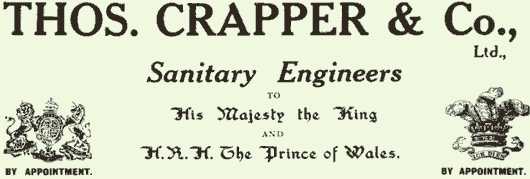
johncoxon 11:50 PM - [Link] - Comments ()
...
NEW ADDITIONS TO OUR HOUSEHOLD
Monday, May 19, 2003
Be prepared to get all broody and doey-eyed because Angela and myself, well we have important news! Two gorgeous female babies today augmented our family number, throwing Labrador Jeff, our loopy doggy chum, into absolute fits of ecstasy and sending black Labrador Beth to the boudoir in a fit of jealous peak. Young Naomi is swooning in sentimental bliss of course. Our two new family members, I am pleased to report, are safe and well. Now I wanted boys and the names 'Stu' and 'Pie', for reasons that will be clear eventually, appealed, but giving in to surrogate daughter, Naomi, (eleven, going on fifty eight) dubbed them 'Tilly' and 'Milly.' Since she was pitching for a horse, well her sensible decision to opt to embrace our new, more economical progeny was quite a relief.
In my previous marriage I had solid, sensible boys, and living in the new world of 'girlies' has been bit of an eye opener and a steep learning curve. How can a bedroom be so disorganised , and disgustingly untidy ? and why is the concept of tidiness so relative? Girls, I have learned, are very messy creatures and spend most of their money on things called 'bobbles', plastic and elastic things that hold back the hair, and these awful, guady, plastic objects, essentially, are dropped anywhere and everywhere and you just buy more and more of them simply to irritate me.
Girls are also, I find, sugar junkies, and awkward about any kind of food that might be healthy and , anything that have a high proportion of sugar or E numbers sustains this species (and anything remotely green and brimming with vitamins is a no-no.)Ah but the new babies! Here is a tempter of a photo -quiz, and it is your job to determine the species.

Oh aren't they cute and oh I am so relieved that we don't have to support a horse. We bought them a mansion, nay, a veritable palace of an abode. Click on the image, having guessed the adopted origin of our new family members. Check your gut feeling.
johncoxon 11:54 PM - [Link] - Comments ()
...
Keith Aldred -Professional Illustrator
Sunday, May 18, 2003
My good friend Keith worked for a long while for the Granada T.V. company, in Manchester, as a graphic designer and I always studied the programme credits for his name at the end of transmissions. As a regular visitor to Keith's welcoming home, I was priviledged to see a lot of the original graphics he did for television. It was also so very interesting to see the various story boards he had produced for programmes and to get such an insight into the way television programmes are put together and to see the background work first hand .
Keith once did the graphics on a detective series, 'El Cid', set in Spain, and featured his idea of title frames having a camera pan over a map of Europe to illustrate the journey from England to Spain. To do this Keith had a huge photograph of a Europe map commissioned so that the rostrum camera could travel over it. The actual photograph used was an astonshing five feet long and four feet wide and cost about £80 to print. Such things are normally thrown away, but Keith kept it , because he is a sensible, sensitive man with a true sense of the real value of things. and later actually gave it to me as a gift. I use it, still, in my classroom, as a teaching aid. It is by far the biggest photograph I have ever seen !
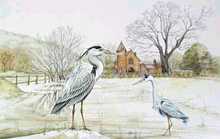
For a long while, Granada featured a wonderful series of Keith's fine art country scenes-wild life paintings for their local weather forecasts. Keith showed me the exquisite originals he still has at home and which he sells as limited edition prints from his own website now. I'd give my right arm for one of those originals but I can only dream. ( Keith, by the way, also has at home, an astonishingly beautful stuffed tawny owl, called Derek, a casualty of a motorway phenomenum where big truck air currents can kill an owl in flight , and he once entrusted to me this precious item into my care for a day so I could show him to my school children
Keith was also regulalry called upon to produce a string of fanstastic colour illustrations to accompany televised children's literature , often bringing to life the characters with his own inventive excellence, sense of humour and graphic skill.
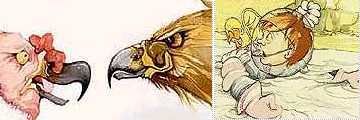
Towards the end of his time at Granada, they produced a fine period drama series based on the Sherlock Holmes stories , with character actor, Jeremy Brett in the lead role ( and openly so appreciative, I hear, of Keith's skill) Keith produced a range of beautifully executed sepia-toned, period feel graphics for the series, some of which are featured on his web site. I have, and cherish, a Sherlock Holmes postcard he sent me which features one of the graphics from the programme he illustrated. 
Sadly, Keith was made redundant from that high-pressure , stressful deadline-based industry and yet, in his retirement, ironically, continued to work for the company, from time to time, on a freelance basis. Keith, fairly recently, set up his own business website, in part through his passion for animals and I kind of think, inspired by his beautiful black flat-backed retriever, (loyal but a tad loopy !)companion 'Lewie.'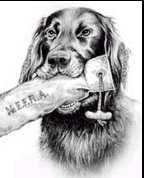
(Hewie: portait by Keith )
and now paints or draws people's pets on a commissioned basis, working often, I think, from photographs.
Keith taught himself web site design and created his own. As with all on line artists, pressures of memory force the reduction of images, and even this stolen screen shot, exquisitly detailed as it is, can't really do justice to the sheer magic of this man's talent and eye for infinite detail which I am so in awe of.
Jeff
We have two beautiful 'gun' dogs who are almost human, just like Keith's constant pal, Hewie. Jeff, our blondish, runt of the litter, totally loopy,intellectually challenged but totally lovable,epileptic Labrador, loves posing for the camera, but Beth, his mother, a black Labrador ( curiously a water gun dog that hates the word 'bath' and any loud noise !) runs for cover at the mere sight of a camera.
You'll know too that black furred animals are notoriously difficult to photograph and of course dog's don't give you the red eye problem with flash photography. They have that more sinister 'flourescent green eye', as the result of lack of a retinas capable of seeing in colour I think. Adobe Photoshop doesn't cover that problem ! I want so very much to own something original from Keith, and ache to commission him to illustrate Angela's two fabulous dogs. I have to figure out the doggie pyschology first that will enable me to provide Keith with a working photograph of Beth before that can happen.
Keith is probably one of the most sensitive, likeable and modest men I ever met and his brief website 'about me' page well I could beef it up considerably, but he wouldn't thank me for it of course. I just hope he will forgive me , for screen capturing a few of the remarkable illustrations from his web site (which is a 'must visit' cyber place) and which, because of the constraints of web page resolution , can only hint at the quality of what he does.
johncoxon 1:16 AM - [Link] - Comments ()
...
While writing again about my home town of Weymouth recently, I felt a sense of frustration that I didn't have and couldn't find any old photographs of the actual cross-channel steam ships and pleasure paddle steamers that were a part of my childhood landscape when I'd spent so many happy hours around the Weymouth harbour area. Whilst the Internet can be a wonderful treasury of images it can also be a source of immense irritation when all the searching leads to a dead end. However, there is always, also, the possibility of accidentally stumbling across something incredibly interesting and that unexpectedly leading, in a roundabout way, to what you were originally looking for. I wonder what the odds are of coming up with something as special as this which has such personal relevance.
I stumbled on an astonishing personal collection of images ; black and white photographs taken at Weymouth by or for an American sailor called Private Allee during the Second World War. Weymouth was one of many ports of embarkation on our southern coast line for American troops during the run up to the Normandy landings. It is poignant to realise that Weymouth may well have been the last hospitable place many of these brave American men ever saw, given the high human cost of that bold but bloody military encounter on the French beaches.

At the age of 8, just some twelve years after these photographs were taken, I had little knowledge then of the harbour being the location for the start of such a momentous event in the war. But these US Navy LST and LCT vessels are moored on cast iron bollards on Weymouth's harbour front ; bollards that you can still see today along with some of the rail track that those huge mobile cranes used to travel up and down in my childhood days but which have now disappeared from the scene.
But this second image is the one that really excited me, not only from the perspective of wonderful documentary evidence that brings home the personal side of historical military events but also in the way that it incidentally captures for me things from the back of my mind that no longer physically exist except in my fond memories. 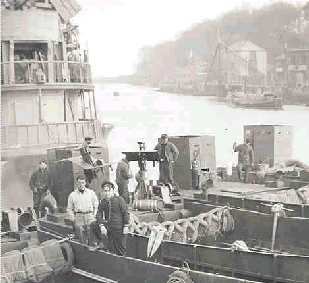
Two things in the picture are things I actually saw as a child, one a huge wooden beam crane that was used to lift small vessels from the harbour into a dry dock where they could be repaired or maintained and the old Weymouth lifeboat .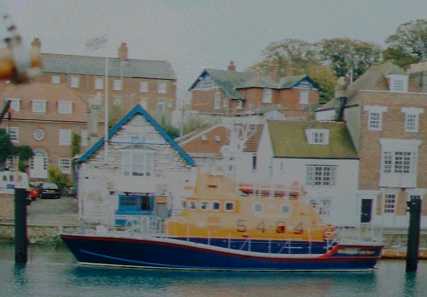
The modern self-righting high speed lifeboat, curiously, still occupies precisely that spot, and the dry dock/ slip way is still in use today but sadly that tall beam crane has disappeared because of someone's lack of foresight.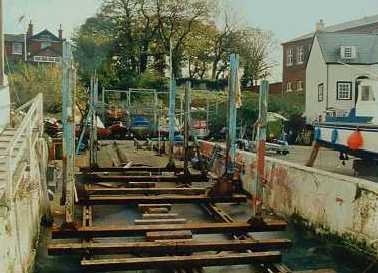
Weymouth today attracts tourists and attempts, successfully, to capitalise on its picturesque harbour with all its fine historic buildings pretty much intact but, sadly. only some of the original harbour side 'furniture' preserved.)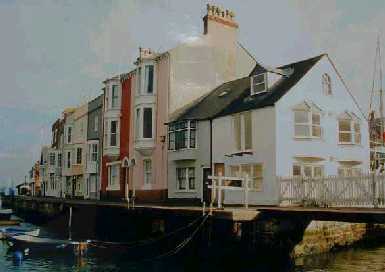
From this wonderful co-incidence in finding these photographs I was able to actually find pictures of some of the vessels I so longed to see again. In the late Victorian period Weymouth was a very popular sea side town and steam powered paddle boats took respectably dressed holiday makers on cruises in Weymouth Bay amd along the Dorset coast. Many of these majestic vessels were used during war time and latterly to help rescue troops during the Dunkirque disaster in the Second World War. Some of these paddle steamers that weren't too badly damaged were restored and still plied their holiday trade into the early sixties. There was a small ship yard called Cosens' in the backwater of Weymouth harbour, which maintained these vessels.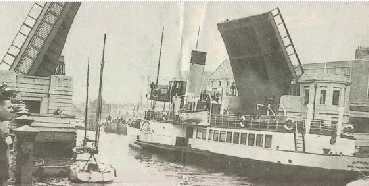
The town bridge had to be raised to let these ships pass on the way to their shipyard for annual maintenance work, shown here in this second image. 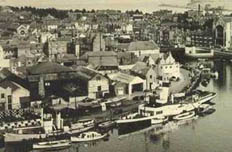
That harbour wall that Private Allee and his comrades' ships were moored at was a place that I remember well because near it was where holiday makers boarded paddle steamers like the Consul,below, in my childhood days.
(There is a comprehensive enthusiast's" web site featuring images of many paddle steamers from the British Isles and other parts of the world in a clickable list which you can access by clicking the bold link word. If you live by a large lake , for example, perhaps you'd find something of local interest to you here.)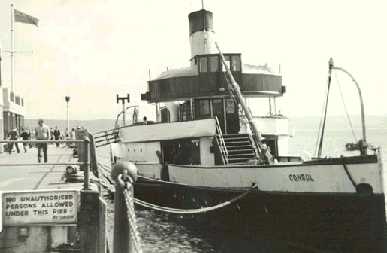
That pier warning sign about 'no unauthorised persons allowed under the pier' was one that all kids saw as an invitation to disobey when the tide was low because there were broad horizontal concrete bases under the pier that you could walk along, fish for crabs and dive into the sea from. We used to swim from near this spot and as I see this picture again I can recall the time, in winter once when we dived from this exact spot into the icy harbour waters to play around with a water polo ball.
I have two medals from this time one dated 1966 and the other dated 1968, when like crazy others I voluntarily plunged into the harbour on Christmas morning for the annual harbour race. We swam across the widest part of the harbour where the old cross-channel steamers used to turn around. The race started from a floating wooden pontoon which used to be used by workmen painting the lower plates of the old steamers and was usually wet with a shallow pool of icy rain water that the older, more hardy competitors took great delight in splashing on we thinner, younger entrants by kicking it up with their bare feet. 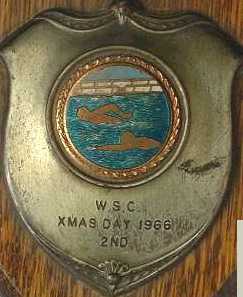
I did find a postcard source of a picture , from at my guess, the mid-to late fifties, of the harbour which shows the Steamer 'St.Partick' but also, I think, the 'St.Helier', both Channel Island steam ships. The latter was one of a pair of rather sinister, grubby looking black-hulled vessels that used to turn in the wide part of the harbour in front of me in my early childhood. You can still see the giant mobile cranes that were in evidence in the war time photograph, but which are no longer there.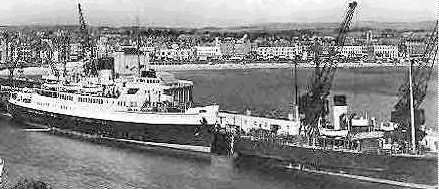
[N.B.The Private Allee images are on a tribute web site to Private Allee and belong to one Brandon Kunicki. Alas although there is an e mail link to this owner, with whom I tried to share my reminiscences and seek permission to use two of the images, the address is a dead link and all e mails got bounced back. That is very frustrating when you feel you know that person would be grateful for additional, first-hand information about what can be seen in the background of some of these pictures]
johncoxon 8:30 PM - [Link] - Comments ()
...
A VERY FITTING TRIBUTE
Today I went for the first time to Liverpool's all-new international airport to help collect some French exchange students and saw this sight that made me smile as I turned into the airport. What a lovely tribute to someone, who for me, was always a special person.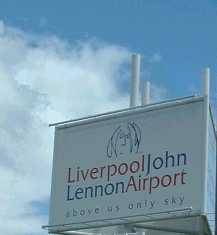
It was in the spring last year, Liverpool Airport became John Lennon Airport and thus the first in the UK to be named after an individual. And it also adopted an affectionate line drawing of John as the airport logo with the banner, part of the lyric from John's universal song ,Imagine, 'above us only sky.' In March this year Yoko came over to the new airport terminal to unveil a 7feet high bronze statue of John. She was presented with a minature of the statue.
She told the press that renaming the airport would promote international understanding and communication. "Communication and exchanging will lead to understanding and understanding will create love and peace. "And the world needs peace," she said.
Amen, I say.
johncoxon 6:30 PM - [Link] - Comments ()
...
THE MORRIS MINOR
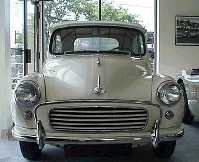
I have been trying to think about what is it about things from my past that so attract and now seem icons and things of beauty and want here to focus on a famous British car that was the U.K equivalent of the V.W. beetle, the ultimate post-war 'people's car', of which this was the British variant.
The Morris Minor is still a sought after vehicle, evoking memories of a time when we still had a partiotic motor industry and what we lacked in design we made up for in quality and reliablity. The Morris Minor, or 'Moggy', as it is affectionately known, was not a particualrly powerful or comforatble vehicle to drive and had associations with steady, older people, out for a Sunday drive. Its basic A series engine was to be the basis of the Mini engine and was incredibly rugged, easy to access and work on and hence it was very easy for the ordinary man to maintain.

The interior was utilitarian and very basic and had that smell of vinyl seating that just about summed it up and was a nasally stimulating feature of all those early cars that you just can't buy canned. At home, I have die cast models of this little car in its saloon and 'traveller' versions.
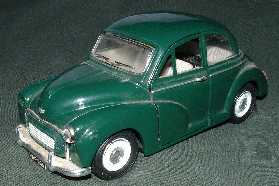
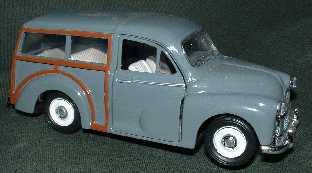
I think they are very well made collectables. I bought these two beauties from a bargain store locally to fuel my nostalgic post-middle-age back page seeking mind set , even though there is a certain irony in their 'Made in China', embossed in their under-floor lettering. In my childhood 'Dinky' and 'Corgi' toys produced such lovely scale-model toy cars which I used to play so happily with.
One of the wonders of the world, and the Internet, is the amazing facility of that awsome Harvard-based search engine 'Google', which allows you to seek images wordwide on any subject and come up with eactly what you wanted.
From it I found two original advertisements for the Morris Minor that set the vehicle in that context of a more peaceful, innocent, and confident Britain. Each has that imagery of domestic tranquility and solidity and the implied suggestion that this little car could further enhance that good fortune.
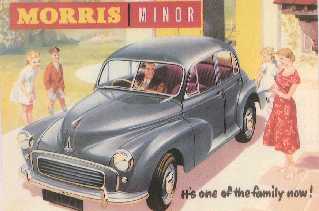
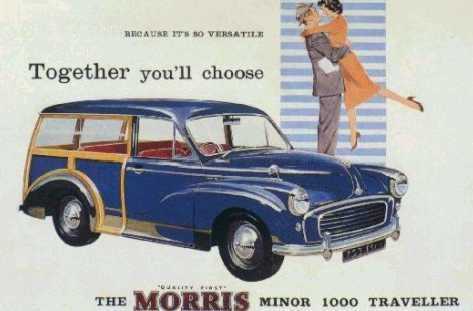
What is it then that has me remembering fondly such cars as these which, if I was less sentimental, I ought to regard as slow, ugly, uncomfortable vehicles? When you look around our car parks today, so many manufacturers of say , the economic, small hatch-back have such very similar designs. It is the shapes, to my mind, of earlier vehicles wherein much of their appeal lies. There wasm't a worry about fuel economy or aerodynamics. You had an engine attached to wheels and you designed a car body in keeping with design characteristics of the day. At motor shows and in the car show rooms, hard to believe now, these designs caused immense excitement and interest then and you clamoured to own the latest model. To us, now, they just seem quaint but also iconic in the sense of that functional 'built to last' quality that has been lost now in that 'built in obscelence' we all now have to deal with and accept. There was here a time when 'Made in Britain' was a sort of assurance, or watch word for something of solid engineering and reliabitily. The old Moggy seems to epitomise that sentiment.
johncoxon 3:19 AM - [Link] - Comments ()
...